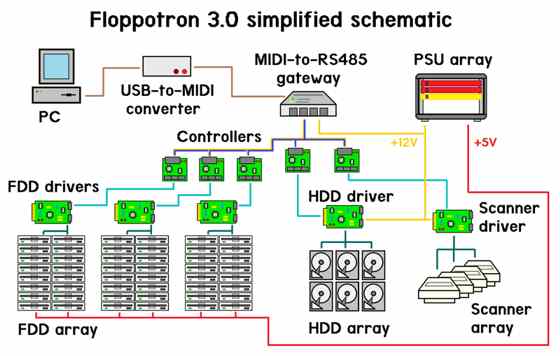| Computer Music - Floppotron 3 |
| Written by Harry Fairhead | |||
| Sunday, 19 June 2022 | |||
|
Computer-generated music is an art form in its own right. But what about music made by obsolete computer hardware? The third generation PC hardware orchestra, Floppotron 3.0, from Paweł Zadrożniak uses 512 floppy disk drives, 16 hard disks and 4 scanners and makes an impressive sound. Any device with an electric motor is able to generate a sound so, as floppy drives use stepper motors to move the head, they can be repurposed to make music. Working on this principle Polish engineer, Paweł Zadrożniak built his original Floppotron in 2011 using two floppy drives and an ARMega microcontroller. In 2016 the second generation Floppotron 2.0 was much bigger with 64 floppy drives, 8 hard drives, and two flatbed scanners and Version 3.0, unveiled this month has double the number of hard disks and scanners and the number of floppy drives is increased eight-fold to 512. Scanners use stepper motors and, as with floppy drives the sounds they generate are depends on their driving speed: the higher the frequency, the greater the pitch. Being larger motorsthey can play higher pitch sounds. Hard disks use a magnet and a coil to position the head. When voltage is supplied for long enough, the head speeds up and hits the mechanical stop making the "drum hit” sound. On his blog post Zadrożniak explains that having bought some random old hard drives all of which had different metal casings and therefore made different sounds, he sorted them by the sounds they made to make the set behave like a drumset. Meet Paweł Zadrożniak and his Floppotron 3.0 in this video: The blog post also has a great deal of technical detail of the hardware and this schematic as an overview.
As far as software is concerned, the Floppotron translates MIDI music files into a series of discrete commands telling the devices when to buzz, click, and remain silent. Using music-composer software, note sequences are encoded as MIDI events, placed on up to 16 tracks. Each track can be assigned to a specific section in the orchestra by changing its program (instrument) parameter. The specific floppy drive stacks play bass tracks, guitar or piano tracks and some of the drum sounds. Hard disks are assigned to drums and scanners play lead tracks. Instruments (or program numbers) can be selected from the list in any MIDI editing software. One downside of this project is the amount of power it requires. As Zadrożniak explains: While scanner moors and hard disk heads don’t need a lot of power, 512 Floppy disk make the numbers go high. One drive consume a relatively large amount of power when making noise – up to 2-2,5W (0,4-0,5A at 5V) depending on drive model and frequency. One stack of 32 drives can draw up to around 16A of current when all drives are active. On the other hand, it does a good rendition of "Entry of the Galdiators" and more music covers are billed as coming soon.
More InformationRelated Articles AI Plays The Instrument From The Music Google Magenta Project - AI Makes Music To be informed about new articles on I Programmer, sign up for our weekly newsletter, subscribe to the RSS feed and follow us on Facebook or Linkedin.
Comments
or email your comment to: comments@i-programmer.info |
|||
| Last Updated ( Sunday, 19 June 2022 ) |




